What is B2B Ecommerce? Benefits, Strategies & Examples For Online Success

The business of selling to other businesses is big business. In 2019, the gross merchandise volume (GMV) of global B2B ecommerce was over $12 trillion, and it is the fastest-growing sales model out there.
In the US alone, B2B ecommerce volume is a staggering $6.4 trillion.
Those are numbers that’ll get your attention. With so much money being poured into this sector of the ecommerce industry, you might find yourself looking to expand your business to accommodate these lucrative sales.
The world of B2B sales involves multiple business models, so B2B sellers are anything but homogenous.
Let’s dig deeper into what B2B commerce is, why it’s so attractive, and what it looks like in its various versions.
In this post, we’ll cover:
- What B2B ecommerce means
- The difference between B2B and B2C selling
- Types of B2B models
- B2B selling benefits
- Trends in B2B ecommerce sales
- Advantages of a B2B ecommerce platform
- B2B ecommerce best practices
- Examples of B2B ecommerce brands
- B2B ecommerce FAQs
Let’s get started.
#cta-visual-pb#<cta-title>Build a high-converting Shopify or BigCommerce store<cta-title>DIY your store design with the best page builder tool by creating stunning store pages and landing pages that drive conversions.Get started today
What is B2B ecommerce?
Business-to-business (B2B) ecommerce is digital commerce between companies of various sizes instead of directly to the end user.
This could be sales:
- Between manufacturers and wholesalers
- Between manufacturers and distributors
- Between wholesalers and retailers or resellers
- Between wholesalers and schools, hospitals, or nonprofits
- Between partnered businesses for the end user
- Through buyer-oriented B2B marketplaces
- Via online portals
As you can see, the B2B landscape is complex.
Traditionally, much of this commerce happened in person, on the phone, or by email. In recent years, this has rapidly moved online (more on that later).
When we talk about ecommerce, most people immediately think of the brands that sell things to them, the end user. These business-to-consumer (B2C) brands are meant for the masses and, for that reason, are more widely known.
In that context, you may wonder how these two ecommerce models differ. We’re glad you asked.
B2B vs B2C: What’s the difference?
The central difference between B2B and B2C is the buyer.
B2C focuses on reaching out to and selling to consumers whose purchases are largely personal (and smaller).
B2B buyers are other businesses whose goals are aligned with their organization’s needs instead of any individual in the company.
Beyond the obvious difference of who the customer is, here are the major differences between B2B and B2C:
- Sales cycle. B2B sales cycles are longer and more complex than B2C sales cycles.
- Repeat purchases. B2B buyers tend to maintain relationships with companies and make regular purchases with them, whereas B2C buyers may only purchase one product from a brand.
- Purchase volume. B2B purchases are much larger than B2C purchases.
- Market size. The B2B ecommerce market is valued at nearly double that of the B2C market ($6.8 trillion vs $3.99 trillion in 2021).
- Decision makers. To finalize a purchase, B2B buyers need group buy-in, where B2C buyers are individuals buying for themselves or someone they know.
- Purchase motivation. B2B buyers are motivated by the needs of the business, and B2C buyers are motivated by their emotions.
- Marketing. B2B purchases are less marketing-driven and more needs-based, whereas B2C buyers often make purchase decisions based on marketing assets.
Types of B2B commerce models
There isn’t just one type of B2B ecommerce site or business model. Let’s look at the various B2B business models ordered by their proximity to the end user.
B2B2C (AKA customer-oriented model)
Certain B2B companies strive to get access to the B2C customer base. That’s where we combine the initialisms into a Frankenstein’s monster that resembles a terrible password.
Enter B2B2C, where a B2B company partners with a B2C company to sell their product or service to the consumer.
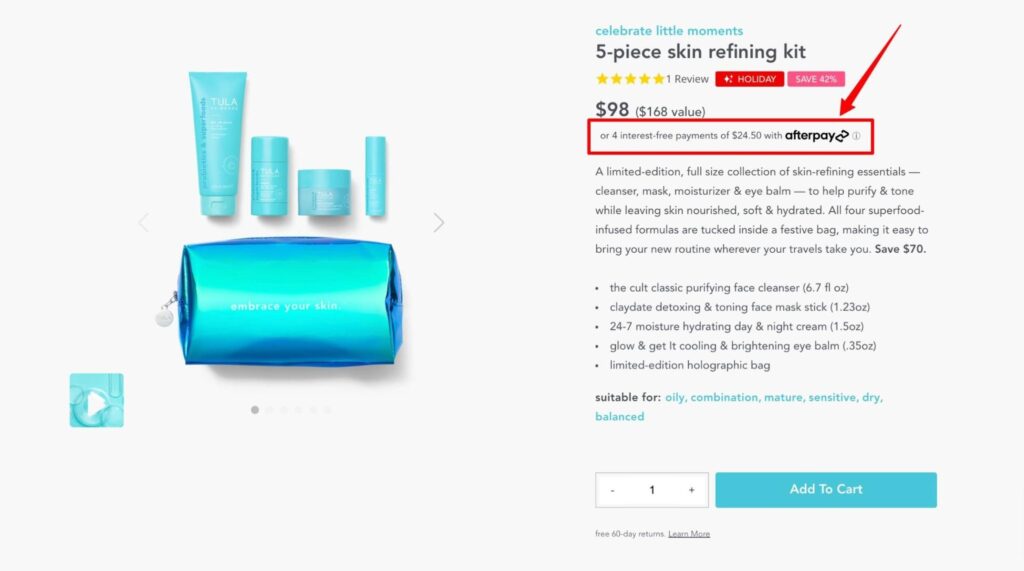
This model is most clearly represented in the rise of the buy now, pay later (BNPL) payment model from companies like Klarna and Afterpay.
These fintech brands partner with ecommerce brands to access their customers and sell to them.
Wholesale (AKA buyer-oriented model)
The wholesale model has businesses buying in bulk from distributors and manufacturers to then sell at retail to the consumer.
Online wholesale marketplaces like Alibaba and DHgate connect buyers with suppliers and manufacturers they’ve vetted beforehand. These buyer-oriented marketplaces make wholesale purchasing easier.
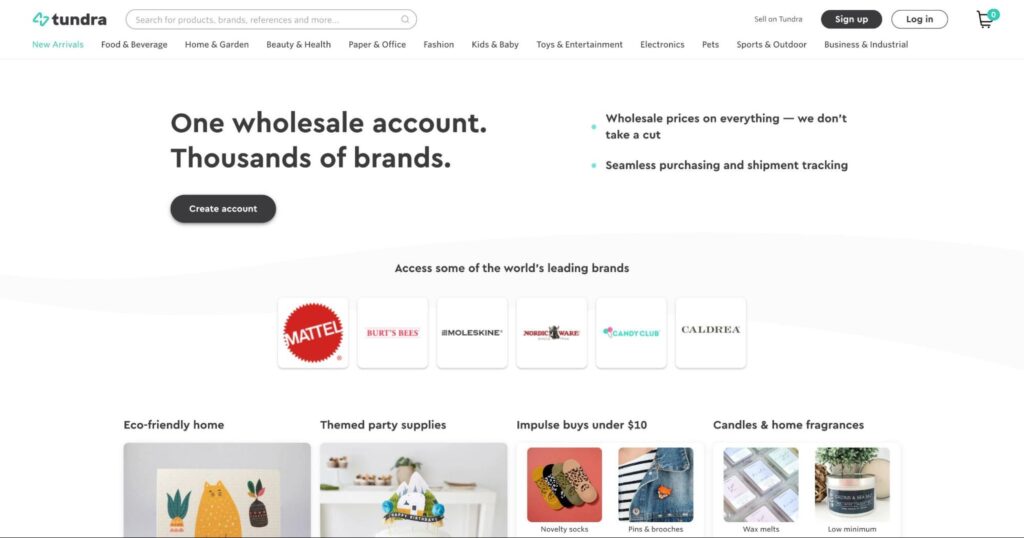
B2C merchants can also get into B2B selling with wholesale portals on their site for businesses to log into. Brands like Copper Cow have used their Shopify store to sell easily to both consumers and businesses.
Distributors (AKA intermediary-oriented model)
Distributors are the logistical piece of the B2B pie, handling the marketing, selling, packaging, and shipping of products from a manufacturer.

While some manufacturers sell directly to other businesses and consumers, many often opt to use an intermediary (the distributor) to close that gap between them and the end user.
Distributors and manufacturers can create partnerships to ensure a mutually beneficial business model. Many businesses utilize Fulfillment By Amazon (FBA) to distribute their products.
Manufacturers (AKA supplier-oriented model)
The beginning of the B2B cycle, manufacturers create products on a massive scale and sell to distributors, wholesalers, retailers, other manufacturers, and sometimes even the end user.
A single product can be the work of multiple manufacturers.
For instance, car companies source a vehicle’s individual parts from other manufacturers. And apparel brands get their fabrics, buttons, and zippers from several different manufacturers.
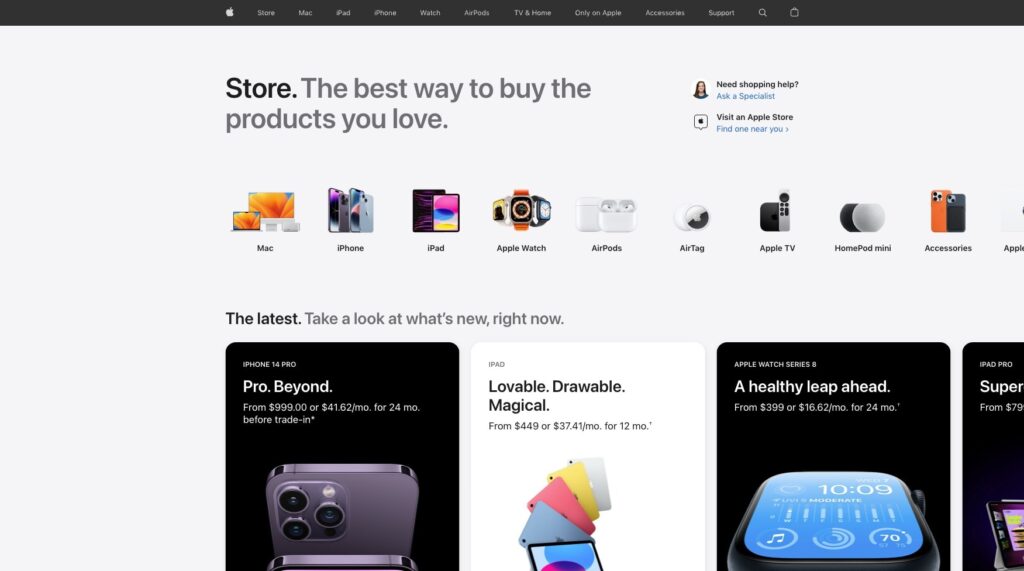
In the case of Apple, they are both supplied by manufacturers (for components) and a manufacturer themselves.
Unlike many manufacturers, Apple sells directly to consumers and businesses.
Benefits of B2B ecommerce
Selling to other businesses has significant advantages for merchants wanting to build and grow a brand. Let’s look at some of the top B2B ecommerce benefits.
- Access to a growing market. The B2B sector is quickly growing, so getting in now means early access to that growth potential.
- Larger individual sales. While sales take longer to close than B2C sales, each sale is worth a lot more for the effort put in.
- Predictable sales. Since B2B customers tend to maintain relationships with their vendors, churn isn’t as high a risk, and sales forecasting is clearer.
- More buyers online. As younger generations become the decision makers for many organizations, these B2B transactions are moving online, giving greater access to those business customers.
- Increased sales potential. Given that the B2B market is so much larger than the B2C market, the potential for sales is enormous.
- Scalability. With the right software in place and your finger on the market’s pulse, scaling your B2B business is easier to accomplish.
- Lower overhead costs. With larger individual orders and the efficiency of bringing systems online, the cost to run a B2B business is lower and can translate to higher revenue streams.
B2B ecommerce trends
While the perception is that B2B commerce happens largely offline, McKinsey found that 65% of B2B brands from various industries are now transacting online.
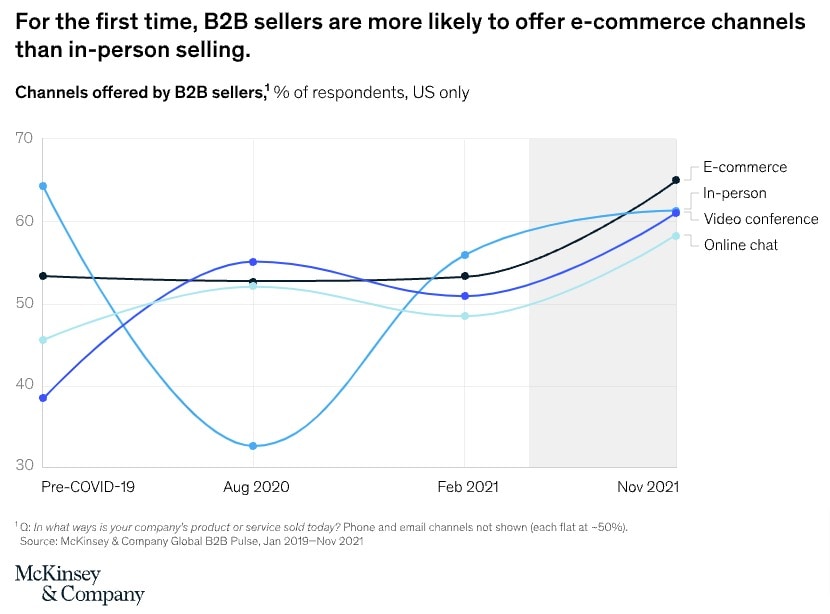
This number was at just 53% in 2021, illustrating how quickly these sellers are realizing the benefits of ecommerce.
According to the same report, ecommerce is now the most effective sales channel for B2B sellers, overtaking in-person, video, online chat, phone, email, and fax.
B2B online sales have seen significant growth since the pandemic’s start. From 2020 to 2021, B2B ecommerce sales grew 17.8% to $1.63 trillion.
And B2B buyers show no signs of going offline again.
At the end of 2021, Gartner found that 72% of B2B buyers recently completed a significant purchase online, and 83% prefer to order or pay online.
With this growth comes some added complexity, especially for sectors that haven’t traditionally operated online.
For manufacturers, receiving and fulfilling ecommerce orders can be a complex affair. According to Statista:
“To engage in e-commerce, manufacturers need to improve their data inventory systems and sync production, storage, and delivery schedules.”
What are the advantages of B2B ecommerce platforms?
You don’t want to run your B2B business without the proper tools to ensure efficiency and scalability.
Gone are the days of relying on fax and phone orders, in-person sales meetings, and complicated spreadsheets to run your business.
It’s essential to have dedicated systems in place to simplify your work.
This includes your product information management (PIM), customer relationship management (CRM), enterprise resource planning (ERP), order management system (OMS), content management system (CMS), ecommerce platform, and frontend layer.
These systems must speak to each other, gophering the right data back and forth to provide unrivaled experiences for merchants and shoppers alike.
To make all these systems play nicely together, you need to have an ecommerce platform that seamlessly ties it together without undue complexity.

Platforms like Shopify Plus, BigCommerce, and Adobe Commerce (Magento) use powerful APIs to connect their vital software as well as marketplaces of useful apps and integrations to extend their usability.
Let’s quickly enumerate the benefits of a good B2B ecommerce platform:
- Easy scalability. With the right technologies, scaling your business becomes easier to manage.
- Expand to new markets. A platform built for B2B sales will allow you to create multiple storefronts for your regional markets or sub-brands.
- Increased sales. By opening your brand up to more markets and simplifying your processes, sales can grow.
- More control over your tech stack. Seamlessly integrating with many different technologies via APIs allows brands to choose their tech stack.
- Simplified processes. Integrating your tech stack with the right platform makes managing your online store easier, letting you get on with running the business.
- Powerful analytics. With the right data and great visualization, you can make better business decisions and provide customers with a better, more personalized experience.
#cta-visual-pb#<cta-title>Build a high-converting Shopify or BigCommerce store<cta-title>DIY your store design with the best page builder tool by creating stunning store pages and landing pages that drive conversions.Get started today
Best practices for B2B ecommerce
Selling to other businesses may resemble B2C selling to a certain degree, but it doesn’t follow the same rules.
As I mentioned earlier, the motivations of B2B buyers are much different than that of B2C buyers. And motivation is everything when it comes to building the right marketing strategy and user experience.
Let’s take a look at some key strategies to consider for B2B ecommerce sales.
Build an online presence
Just as B2C commerce has increasingly moved online, B2B buyers now prefer researching and buying online instead of connecting by phone, email, or in person.
That means B2B merchants need to spend more energy developing their online presence to be top of mind throughout their purchasing journey.
You need to understand how these customers find vendors online so you can be there when they start (and end) their research.
As with many consumers, these buyers use search engines to research potential purchases.
That means you should create product-led content that answers their questions, starting at the top of the funnel with broad topics all the way down to the bottom of the funnel with product-centric details.
You can create content such as how-to guides, ebooks, FAQs, size guides, etc.
Find your audience with targeted ads
Especially as you are trying to get traction online, you need to find a quick way to get in front of your ideal audience.
While your SEO content will be decisive in the long term, it will take time to rank and start seeing traffic. Paid ads—via Google, Facebook, LinkedIn, etc.—waste no time getting your brand to the masses.
Each has its own targeting mechanisms—keywords, job titles, likes, demographics—that help you get to just the right people. And, you only pay when they click, or you get enough views.
Create totally unique shopping experiences
When shopping around, buyers see a lot of websites. If you don’t stand out, you’ll be easily forgotten.
That’s why merchants are spending more time creating memorable storefronts with rich merchandising and custom shopping experiences.
To facilitate this, many B2B brands use drag-and-drop page builder tools to balance showing off their unique products with a memorable online experience.
Streamline the checkout experience
The customer experience doesn’t end once they’ve finalized their shopping cart.
You need to consider how smooth their checkout experience is and where you can make it simpler and just as helpful as the rest of their shopping experience.
While the buyer is intent on completing their purchase here, it doesn’t mean they couldn’t be convinced to add to their order with personalized recommendations. With B2B orders being larger and fewer, it’s crucial that they leave with everything they need.
Checkout is also where you give them their options for shipping and warranty info, so give them the right details and enough flexibility to make their last interaction with you positive.
Speed up fulfillment
The last leg of the buyer’s experience with you is when their order lands at their door.
To make this experience the best it can be for you and your customers, you should leverage a distributor that can deliver quickly while keeping you on budget.
With the right order fulfillment company, you can provide excellent post-purchase service and take work off your team’s plate.
Add buy now, pay later functionality
Payments in B2B sales can be a limiting factor in the size of customer orders as they manage their cash flow.
Adding additional payment options, like BNPL, for your B2B customers can increase order sizes and simplify their ordering process.
Beyond that, you can also offer discounts for paying early, which can help ensure better ongoing relationships with your customers.
Enable auto-replenishment and reorders
Your B2B buyers are doing a job when they purchase from you, and, like most people, they want to simplify their work. When it comes to repeat orders, auto-replenishment is a time saver.
Same for the ability to easily reorder items they commonly buy.
Giving them an easy-to-access record of their orders and the ability to click one button to reorder gives them time to do something else, which is what we all really want.
Invest in excellent customer service
With larger orders and fewer buyers, it makes sense to provide high-touch customer support to build valuable relationships with your buyers.
Customer retention is key to growing your B2B brand, so build a customer support team that can keep buyers happy and reliably coming back for more.
Dedicated account managers can give a personal touch to customer service, with buyers knowing they always have someone ready to help them out.
Go omnichannel
Omnichannel commerce is all about showing up where your customers are.
Instead of needlessly spending time and money on every sales and marketing channel, focus your efforts on the places your customers will be and provide them with a consistent experience across those channels.
That means building great content for SEO and sales enablement, implementing focused paid ad campaigns, staying top of mind on social media, integrating your online presence into offline experiences, and fulfilling orders in creative ways.
B2B ecommerce examples
Now that we’ve got a handle on what B2B commerce is, what it looks like online, and how to make it happen for your brand, let’s look at some B2B success stories.
Amazon Business – The wholesale arm of the B2C juggernaut
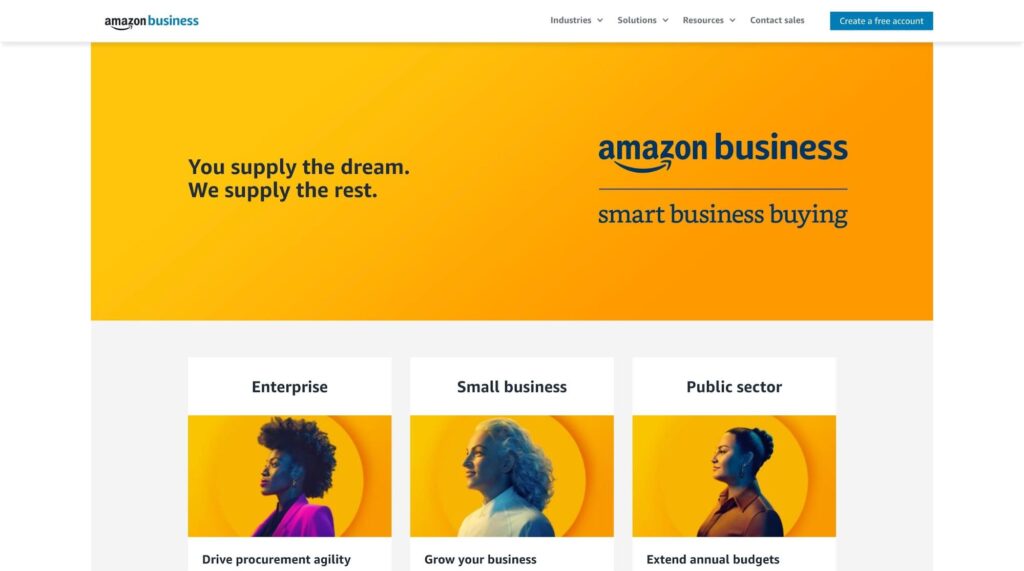
Everyone knows Amazon at this point, but most of us don’t think of them as a B2B brand.
Their B2B arm, Amazon Business, is a perfect example of wholesale ecommerce for offices, schools, and various other types of businesses.
By 2025, Statista projects that Amazon Business will hit a GMV of $83.1 billion. Their GMV was at $31.5 billion in 2021, so their growth trajectory is steep.
Just like with their B2C business, they realize this success by offering just about everything a company might need and making the process super easy for all team members.
They sell supplies for the office, the breakroom, beauty salons, restaurants, the IT department, sanitation, hospitals, and more.
Copper Cow Coffee – A DTC brand leveraging a B2B ecommerce portal
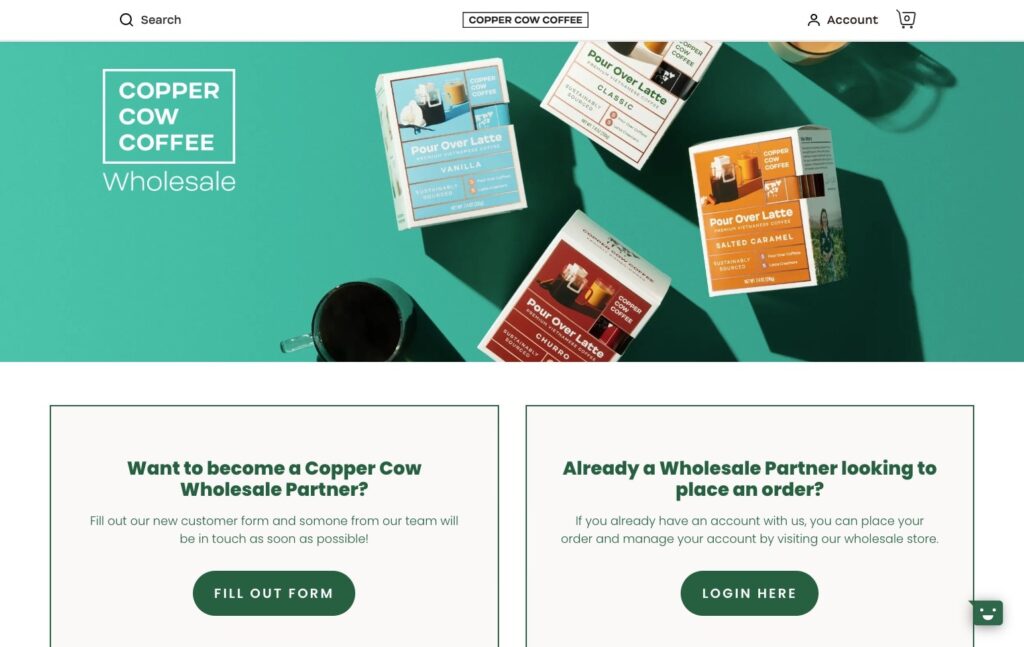
Copper Cow Coffee is an innovative direct-to-consumer (DTC) brand, selling sustainable single-use Vietnamese pour-over lattes to people wanting a little different from their morning brew.
While their ecommerce site is primarily aimed at the end user, they also run a healthy B2B wholesale operation. Whole Foods even stocks them!
Utilizing Shopify Plus, Copper Cow is able to create an online portal for wholesale customers. Businesses fill out a form and, if approved, get login credentials for ordering online.
#cta-paragraph-pb#To entice potential customers, Copper Cow uses a landing page built with Shogun Page Builder.
Theo Chocolate – A wholesale program for CPG retailers
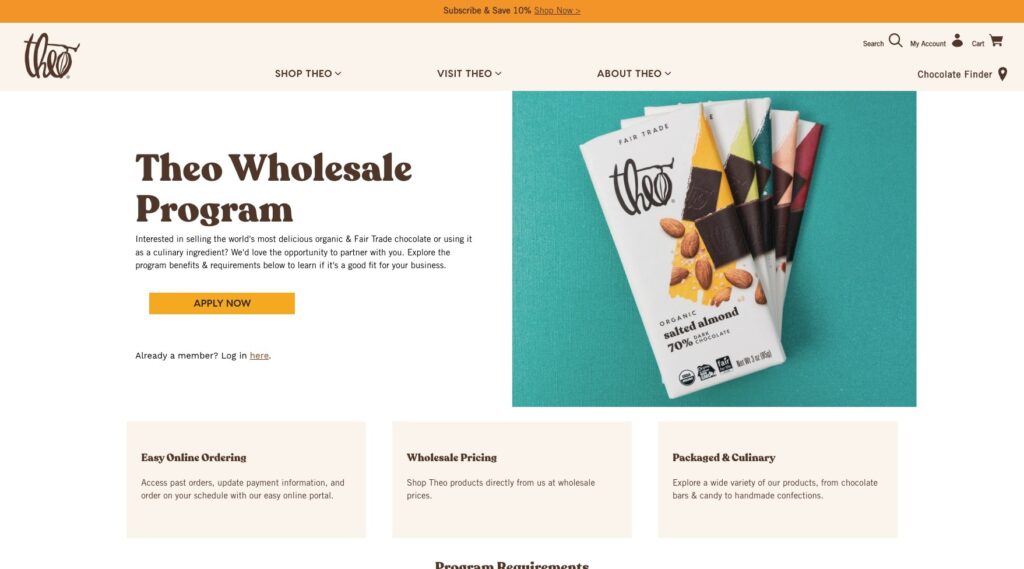
The Seattle-famous chocolatier runs a healthy B2C business from their humble chocolate factory, but you can also find them at stores far and wide. This is thanks to their wholesale program.
On their website, retailers and restaurants can apply to get wholesale pricing on their huge selection of packaged chocolate and culinary ingredients.
Businesses can use their easy online portal to get what they need and reorder on their schedule when approved.
Ice Cobotics – A futuristic cleaning solution for various industries

Ice Cobotics is a different kind of B2B company from the other examples here.
They build amazing cleaning robots for all types of buildings—hospitals, hotels, airports, grocery stores, manufacturers, etc—and offer them in a subscription format.
These high-end vacuums and scrubbers are equipped with autonomous technology and data analytics, making cleaning a hands-off affair.
Their stunning website shows off their product line with powerful images and animations.
Interested businesses start with a discovery call and go from there. From there, they have an online portal for managing the equipment subscription.
noissue – A B2B (and B2C) custom sustainable packaging brand
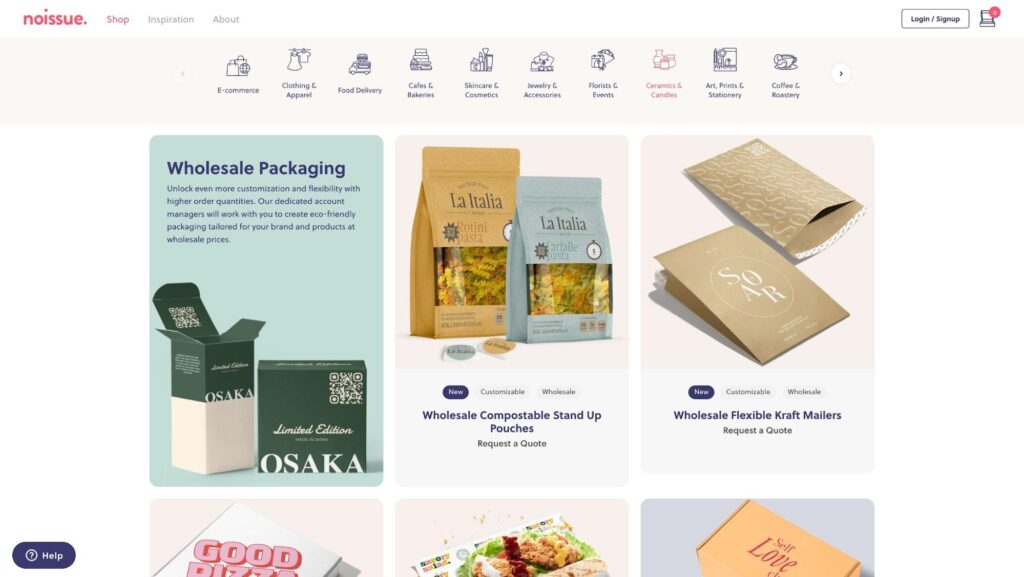
Ecommerce brands need many things to be successful, but few things are as vital as what they package their products in.
Packaging brand noissue creates all manner of custom packaging products for brands across industries.
Whether it’s boxes, mailers, and labels for shipping or bags, totes, and cups for product packaging, noissue has sustainable solutions that are customizable for your brand.
For brands that want to create rich experiences across the customer journey, using custom packaging can deliver that brand identity all the way to the unboxing experience.
#cta-visual-pb#<cta-title>Build a better ecommerce storefront<cta-title>You can build the store your product deserves with Shogun Page Builder.Start building for free
B2B ecommerce FAQs
What is the market size of B2B ecommerce?
In 2021, the global B2B ecommerce market size was valued at USD$6.88 trillion. It is projected to grow at a compound annual growth rate of 19.7% from 2022 to 2030.
To compare, the B2C market size was valued at $3.99 trillion in 2021.
What are the defining features of B2B ecommerce selling?
Some of the most standout features of B2B selling are large order sizes, longer sales cycles, needs-based purchase motivation, minimum order quantities, and online portals.
Is B2B more profitable than B2C?
B2B has the potential to be more profitable than B2C, though it may not always be the case.
Since B2B customers make larger purchases and are often repeat buyers, these businesses can achieve higher profits.
That said, the customer base for many B2C brands is much larger than for B2B brands, even with smaller purchase sizes.
Build an efficient ecommerce strategy for your B2B brand
While B2B commerce isn’t for everyone, you can’t deny its momentum. For those curious about selling to other businesses, this is a great time to hop on.
Seeing B2B selling find its ecommerce legs so quickly after relying on offline tactics for so long illustrates how savvy merchants can be when they see the opportunity.
But it takes more than just creating a website with a form to fill.
B2B sellers can take advantage of the strategies that online B2C merchants have been sharpening for years. Rich merchandising, targeted marketing messaging, omnichannel strategy, and customer education are critical to your success.
As long as you understand your customer, you will surely thrive in B2B commerce.
#cta-visual-pb#<cta-title>Create a truly custom storefront for your B2B brand<cta-title>You can build the store your product deserves with Shogun Page Builder.Start building for free

Sean Flannigan
Sean is one of Shogun's tireless content marketers. When he isn't creating exciting ecommerce content, he's probably biking or at the park.



